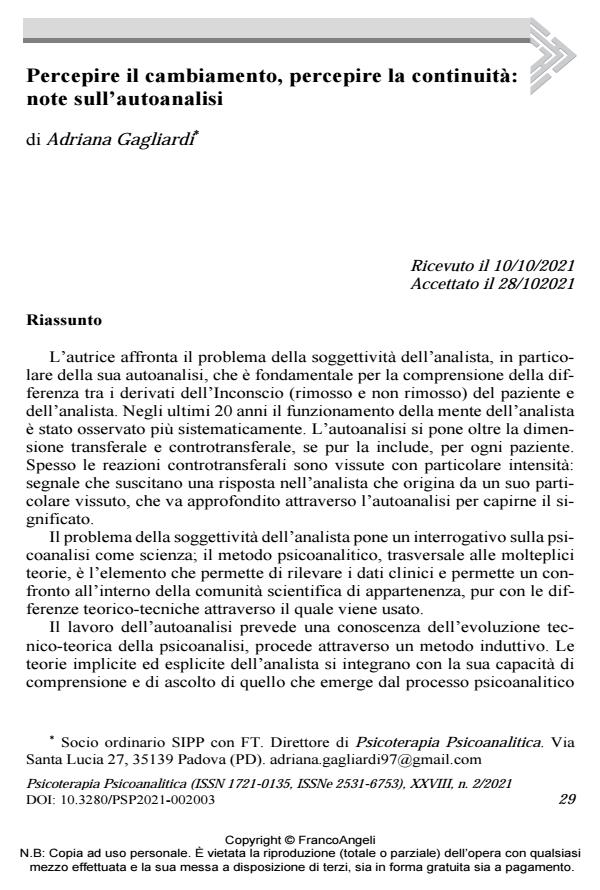Perceiving change, perceiving continuity: notes on self-analysis
Journal title PSICOTERAPIA PSICOANALITICA
Author/s Adriana Gagliardi
Publishing Year 2021 Issue 2021/2
Language Italian Pages 23 P. 29-51 File size 229 KB
DOI 10.3280/PSP2021-002003
DOI is like a bar code for intellectual property: to have more infomation
click here
Below, you can see the article first page
If you want to buy this article in PDF format, you can do it, following the instructions to buy download credits

FrancoAngeli is member of Publishers International Linking Association, Inc (PILA), a not-for-profit association which run the CrossRef service enabling links to and from online scholarly content.
The author tackles the problem of the analyst’s subjectivity, in par-ticular his self-analysis, which is fundamental for understanding the difference between the derivatives of the unconscious (repressed and not repressed) of the patient and that of the analyst. Over the past 20 years, the functioning of the analyst’s mind has been observed more systematically. Self-analysis goes beyond the transference and counter-transference dimension, if it does include it, for each patient. Counter-transference reactions are often experienced with particular intensity: a signal that elicits a response in the analyst that originates from a partic-ular experience of his, which must be deepened through self-analysis, and which sometimes requires a discussion with colleagues to under-stand its meaning. The problem of the analyst’s subjectivity raises a question about psychoanalysis as a science; the psychoanalytic meth-od, transversal to the many theories, is the element that allows to detect clinical data and allows a comparison within the scientific community to which it belongs, even with the theoretical-technical differences through which it is used. The work of self-analysis involves a knowledge of the technical-theoretical evolution of psychoanalysis, proceeds through an inductive method. The analyst’s implicit and ex-plicit theories are integrated with his ability to understand and listen to what emerges from the psychoanalytic process and change over time. We look at transference and repetition as a possibility to open up to new transformative and vital experiences. For self-analysis, a particular way of listening to the repetition of particular aspects in the transfer-ence is proposed, transference-countertransference segments are iden-tified, in order to use a method that can make clearer a difference be-tween what concerns the patient’s experiences, from those of the ana-lyst. Three explanatory clinical flashes are also described of the evolu-tion of some of the author’s reference theories over time.
Keywords: self-analysis, subjectivity, psychoanalytic method, transfer-ence, countertransference, explicit/implicit analyst’s theories.
Adriana Gagliardi, Percepire il cambiamento, percepire la continuità: note sull’autoanalisi in "PSICOTERAPIA PSICOANALITICA" 2/2021, pp 29-51, DOI: 10.3280/PSP2021-002003